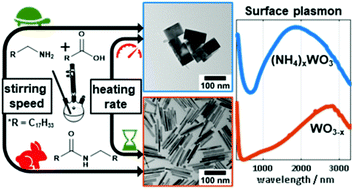Gram-scale selective synthesis of WO3−x nanorods and (NH4)xWO3 ammonium tungsten bronzes with tunable plasmonic properties†
Abstract
Localized surface plasmon resonance properties in unconventional materials like metal oxides or chalcogenide semiconductors have been studied for use in signal detection and analysis in biomedicine and photocatalysis. We devised a selective synthesis of the tungsten oxides WO3−x and (NH4)xWO3 with tunable plasmonic properties. We selectively synthesized WO3−x nanorods with different aspect ratios and hexagonal tungsten bronzes (NH4)xWO3 as truncated nanocubes starting from ammonium metatungstate (NH4)6H2W12O40·xH2O. Both particles form from the same nuclei at temperatures >200 °C; monomer concentration and surfactant ratio are essential variables for phase selection. (NH4)xWO3 was the preferred reaction product only for fast heating rates (25 K min−1), slow stirring speeds (∼150 rpm) and high precursor concentrations. A proton nuclear magnetic resonance (1H-NMR) spectroscopic study of the reaction mechanism revealed that oleyl oleamide, formed from oleic acid and oleylamine upon heating, is a key factor for the selective formation of WO3−x nanorods. Since oleic acid and oleylamine are standard surfactants for the wet chemical synthesis of many metal and oxide nanoparticles, the finding that oleyl oleamide acts as a chemically active reagent above 250 °C may have implications for many nanoparticle syntheses. Oriented attachment of polyoxotungstate anions is proposed as a model to rationalize phase selectivity. Magic angle spinning (MAS) 1H-NMR and powder X-ray diffraction (PXRD) studies of the bronze after annealing under (non)inert conditions revealed an oxidative phase transition. WO3−x and (NH4)xWO3 show a strong plasmon absorption for near infra-red light between 800 and 3300 nm. The maxima of the plasmon bands shift systematically with the nanocrystal aspect ratio.



 Please wait while we load your content...
Please wait while we load your content...